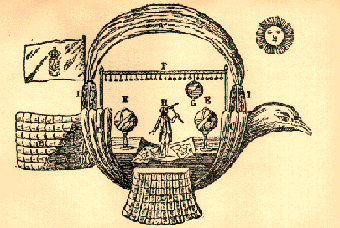
1685-1724 |
 |
Photo Courtesy Museo do Ar Portuguese Air Force |
|
Bartolomeu de Gusmão belongs to that group of individuals who stand out in the history of Humanity, in the field of sciences with his notable invention, joining the gallery of our national glories and those of the World, with primary relevance to the field of air navigation. Between 1708 and 1709, Bartolomeu de Gusmão, already having joined the priesthood, embarked for Lisbon, capital of the Empire, in order to pursue his quest for knowledge. At the University of Coimbra, he devoted himself to the studies of Mathematical Science, moving beyond Astronomy, Mechanics, Physics, Chemistry and Philosophy. He also studied the disciplines of Diplomacy and Cryptography, having been granted the designation of D. João V, having graduated on May 5, 1720. He next completed the Doctoral Course of the College of Rules at the University of Coimbra, on June 16, 1720. It was a soap bubble rising in the hot air surrounding the flame of a candle that challenged the intelect of Gusmão to consider the difference between the densities of air. An object lighter than air could should then be able to fly! On April 19, 1709, he announced that he would present a flying machine to the court.. He received authorization from King D. João V to demonstrate his invention before the Royal House. On August 3, 1709, he made the first attempt in the Hearing Room of the Palace. However, the small balloon made of paper was set on fire before it could rise in flight. Two days later, a second attempt was successful: the balloon went up about 20 palmos, to the astonishment of the assembly. Fearing the possibility of a fire, the palace servants attacked the device before it had reached the ceiling. Three days later, on August 8, 1709, the third trial was made in the Patio of the House of India before D. João V, queen D. Maria Anad and Habsburgo, the Papal Messenger Conti Cardinal, the infant D. Francisco of Portugal, the Marquês de Fonte, nobles and ladies of the Court and other personages. This time he had total success. The balloon had risen slowly, then started to fall, having exhausted the flame, into theTerreiro do Paço. The first lighter-than-air device having been constructed, The King was so impressed that he granted to the right any and all flying ships to Gusmão from then on. And for all those who dared to intervene or to copy his ideas, the penalty would be the death.  Passarola Photo Courtesy Museo do Ar Portuguese Air Force The invention of the Priest was called Passarola, because of its resemblance to a bird. It was filled with numerous tubes, through which the wind flowed and filled out the bulges which gave it shape. The conception and construction of the airship by Bartolomeu de Gusmão, represented the first gigantic step which was represented by his invention, from which would come the airplane, Bartolomeu de Gusmão is properly considered to be the Father of the Airship, having preceeded by 74 years the Montgolfier brothers, who flew in a hot air balloon in 1783. Bartolomeu de Gusmão was a singular figure, in which the man, the priest and the gifted one were so well blended into a complex personality, that he was forced to the frontiers of his time, suffering the natural and inevitable consequences of his exceptional nature. Father Bartolomeu Lourenço de Gusmão died on November 18, 1724 in Toledo, Spain, being identified by the events as the first and most beautiful page in the history of Aeronautics. on theBartolomeu Lourenço de Gusmão page of the Brazilian Air Force website. |
The two illustrations you found on this page were made available through the courtesy of the Air Museum, Museo do Ar, section of the Portuguese Air Force. I highly recommend that you visit their site, which has a button which provides the text in English translation. I think you will be fascinated by the stories which are told about the history and the present activities of this organization, so often unavailable and unknown to those of us who don't speak the language. To visit their homepage, just click on: To enable the English translation, click on the Union Jack button. Be sure to visit the "Gallery", especially the "Aircraft Retired" section. You will find pictures of some of our old favorites. |
|
If you have any information on this Early Flier, please contact me. E-mail to Ralph Cooper 

|